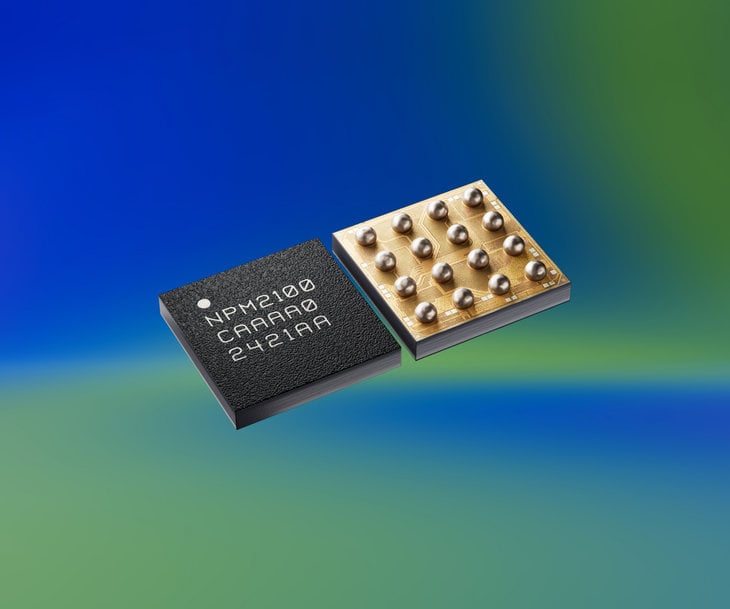Nordic Semiconductor’s nPM2100 Power Management IC extends battery life of primary cell-powered Bluetooth Low Energy products
The nPM2100 PMIC incorporates an ultra-efficient boost regulator and a wide range of energy-saving features to significantly extend operating time in non-rechargeable battery applications.
www.nordicsemi.com

Nordic Semiconductor, a global leader in low power wireless connectivity solutions, today announces a further addition to its nPM family of Power Management ICs (PMICs). The nPM2100 PMIC prolongs the operating time per battery for primary (non-rechargeable) battery applications by managing energy resources using an ultra-efficient boost regulator and a wide range of energy-saving features. Application examples for the nPM2100 include wireless mice and keyboards, consumer asset tracking, remote controls, and body-worn medical devices.
According to CORDIS, 28 billion primary batteries are discarded worldwide each year[1] and manufacturing a primary battery requires, on average, 50 times the energy it stores, making it an extremely inefficient energy source[2]. Worse yet, inefficient power management wastes a substantial part of the stored energy, resulting in many batteries being thrown away before they are fully depleted. The nPM2100’s boost regulator and unique energy-saving features—including primary-cell fuel gauging—address power management inefficiencies while also ensuring that all the battery’s stored energy is used before the cell is thrown away.
“Not all IoT products can rely on rechargeable batteries or energy harvesting to operate. This means that primary batteries aren’t going away any time soon,” says Geir Kjosavik, Product Director - PMICs, at Nordic Semiconductor. “However, by using the nPM2100, designers will be able to access much more of the energy stored in those primary cells, making products last longer between battery changes or allowing the use of smaller batteries for the same battery life - resulting in more compact, lighter, and less expensive products.”
High-efficiency power management IC for battery applications
The nPM2100 targets primarily battery applications. Examples of supported batteries are one or two AA/AAA/LRxx batteries (in series), or one 3 V LiMnO2 cell. Single- or dual-cell silver oxide and zinc-air coin-cell batteries are also supported, plus any other primary battery that operates within the nPM2100’s input voltage range.
The nPM2100 features a boost regulator with an output range of 1.8 to 3.3 V, powered from an input range of 0.7 to 3.4 V. The regulator can deliver up to 150 mA maximum current. The regulator also powers a Load Switch/LDO supplying up to 50 mA across an output range of 0.8 to 3.0 V. The regulator features a quiescent current (IQ) of 150 nA and delivers up to 95 percent power conversion efficiency at 50 mA and 90.5 percent efficiency at 10 µA, making it one of the most efficient contemporary boost regulators on the market.
Specialized energy-saving features
The nPM2100 PMIC features a low current ship mode that enables products to be transported with the battery inserted. The ship mode supports a 35 nA sleep current with multiple wakeup options, including a patent-pending ‘break-to-wake’ function. It also features an ultra-low power wakeup timer that can run concurrently with ship mode to allow timed wakeups. The timer can be used for a deeper sleep setting than the power-off of a SoC or MCU can provide. The nPM2100’s total current draw in hibernate mode is less than 200 nA.
A voltage and temperature-based fuel gauge running on the host microprocessor also enables more accurate battery level measurements and enables users to access all the energy in the battery with confidence.
Ultra-compact packages and availability
Samples of the nPM2100 are available now in a compact 1.9 by 1.9 mm WLCSP and a versatile 4 by 4 mm QFN package and the nPM2100 is expected to be in full volume production during the first half of 2025. Interested parties can contact their local Nordic sales representative for more information.
References:
2. Hill, Marquita K. (2004). Understanding Environmental Pollution: A Primer. Cambridge University Press. pp. 274. ISBN 0521527260.
www.nordicsemi.com

